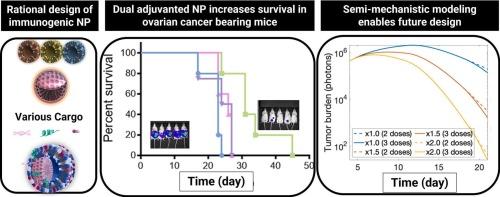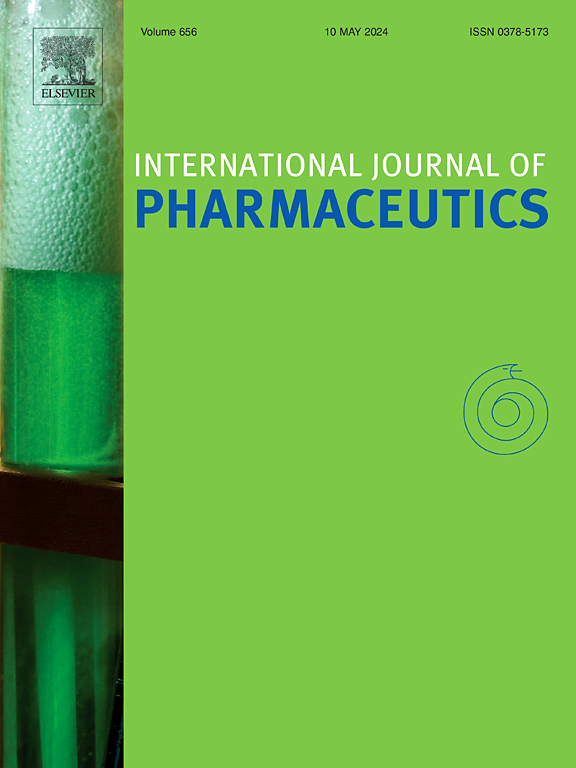合理设计免疫原性纳米颗粒作为减轻小鼠卵巢肿瘤负荷的平台。
IF 5.2
2区 医学
Q1 PHARMACOLOGY & PHARMACY
引用次数: 0
摘要
卵巢癌免疫治疗仍然是一个基于“冷”肿瘤微环境的挑战。在此,我们提出了一种合理的设计,以创建免疫原性纳米颗粒作为多药物平台,促进卵巢癌小鼠模型的免疫反应。混合脂质-二氧化硅纳米系统能够共同装载四种类型的货物分子,包括模型抗原,核酸基胞嘧啶-p-鸟嘌呤佐剂(CpG, TLR3/9激动剂),糖脂基佐剂单磷酰脂质a (MPL, TLR4激动剂)整合到脂质外壳中。纳米平台在脂质组成、功能化二氧化硅树突核形成和最终电荷方面的优化,以及它们与复杂负载谱的兼容性,突出了与单一疗法相比,提高晚期卵巢癌小鼠存活率的机会。在纳米颗粒配方中加入CpG可提高卵巢癌小鼠的存活率。为了解释这些结果并指导未来的设计,我们还开发了纳米颗粒驱动免疫激活的数学模型,该模型量化了治疗效果并确定了控制肿瘤反应的关键参数。所提出的混合纳米颗粒是可调的,因此能够传递替代分子,从而突出了治疗腹膜癌的有希望的平台。本文章由计算机程序翻译,如有差异,请以英文原文为准。

Rational design of immunogenic nanoparticles as a platform to reduce ovarian tumor burden in mice
Ovarian cancer immunotherapy remains a challenge based on the “cold” tumor microenvironment. Herein we present a rational design to create immunogenic nanoparticles as a multi-agent platform that promotes immune response in a mouse model of ovarian cancer. The hybrid lipid-silica nanosystem is capable of co-loading four types of cargo molecules including a model antigen, nucleic acid-based adjuvant cytosine-p-linked to guanine (CpG, TLR3/9 agonist), glycolipid-based adjuvant monophosphoryl lipid A (MPL, TLR4 agonist) integrated into the lipid coat. The optimization of the nanoplatform in terms of lipid composition, functionalized silica dendritic core formation, and final charge, as well as their compatibility with the complex loading profile highlights an opportunity for enhanced survival of mice with advanced ovarian cancer compared to monotherapy. The inclusion of CpG in the nanoparticle formulation enhanced the survival of mice with ovarian cancer. To interpret these outcomes and guide future design, we also developed a mathematical model of nanoparticle-driven immune activation, which quantified treatment efficacy and identified key parameters governing tumor response. The presented hybrid nanoparticle is tunable, enabling delivery of alternative molecules therefore, thereby highlighting a promising platform for the treatment of peritoneal cancers.
求助全文
通过发布文献求助,成功后即可免费获取论文全文。
去求助
来源期刊
CiteScore
10.70
自引率
8.60%
发文量
951
审稿时长
72 days
期刊介绍:
The International Journal of Pharmaceutics is the third most cited journal in the "Pharmacy & Pharmacology" category out of 366 journals, being the true home for pharmaceutical scientists concerned with the physical, chemical and biological properties of devices and delivery systems for drugs, vaccines and biologicals, including their design, manufacture and evaluation. This includes evaluation of the properties of drugs, excipients such as surfactants and polymers and novel materials. The journal has special sections on pharmaceutical nanotechnology and personalized medicines, and publishes research papers, reviews, commentaries and letters to the editor as well as special issues.

 求助内容:
求助内容: 应助结果提醒方式:
应助结果提醒方式:


